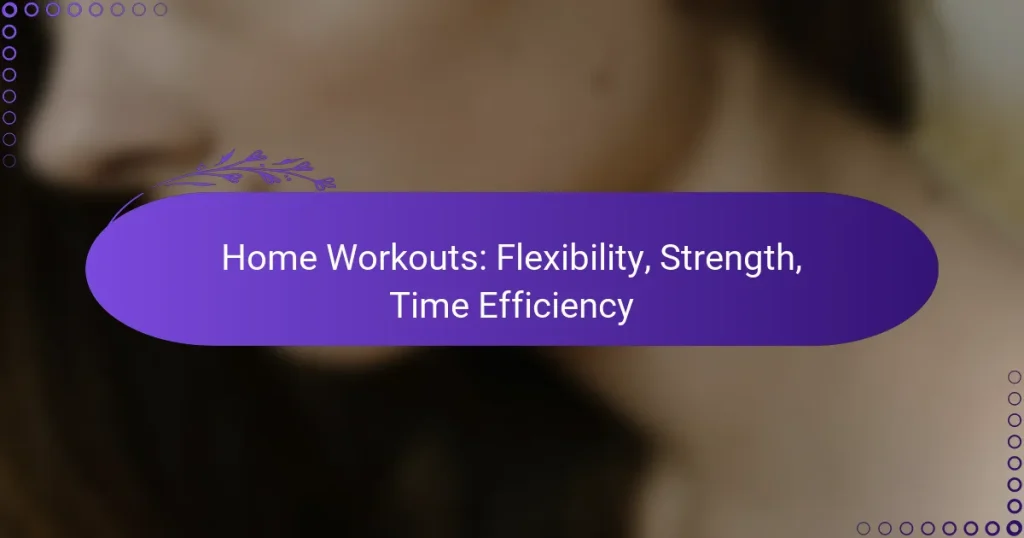Home workouts offer a convenient way to enhance flexibility and strength while accommodating busy schedules. By incorporating effective techniques, you can improve your range of motion, build muscle, and achieve your fitness goals in minimal time. Whether using bodyweight exercises or resistance tools, these workouts can be tailored to fit your needs and space.

What are effective home workouts for flexibility?
Effective home workouts for flexibility focus on improving the range of motion in your joints and muscles. Incorporating various techniques can enhance overall mobility, reduce injury risk, and promote relaxation.
Yoga routines
Yoga is a highly effective method for enhancing flexibility through a series of poses that stretch and strengthen the body. Popular styles like Hatha or Vinyasa can be practiced at home with minimal equipment, often requiring just a mat. Aim for sessions of 20-60 minutes, focusing on poses such as Downward Dog, Cobra, and Pigeon to target different muscle groups.
To maximize benefits, consider following guided online classes or apps that cater to your skill level. Consistency is key; practicing several times a week can lead to noticeable improvements.
Pilates exercises
Pilates emphasizes core strength and stability, which can significantly enhance flexibility. Exercises like the Spine Stretch, Saw, and Leg Circles promote elongation of muscles while improving posture. A typical session can last from 30 to 60 minutes and requires minimal equipment, such as a mat or resistance band.
Focus on controlled movements and proper breathing to fully engage your muscles. Incorporating Pilates into your routine two to three times a week can yield substantial flexibility gains.
Dynamic stretching
Dynamic stretching involves moving parts of your body through a full range of motion to warm up muscles and increase flexibility. Activities like leg swings, arm circles, and torso twists are effective and can be performed before workouts or sports activities. Spend about 5-10 minutes on dynamic stretches to prepare your body for more intense exercise.
Ensure movements are smooth and controlled to avoid injury. This technique is particularly beneficial for athletes or anyone engaging in physical activity, as it helps improve performance and reduce stiffness.
Foam rolling techniques
Foam rolling is a self-myofascial release technique that helps alleviate muscle tightness and improve flexibility. By applying pressure to specific muscle groups, you can enhance blood flow and reduce soreness. Target areas such as the calves, thighs, and back for 1-2 minutes each, focusing on tender spots.
Incorporate foam rolling into your routine before or after workouts for optimal results. It’s a simple yet effective way to maintain flexibility and promote recovery, making it a valuable addition to any home workout regimen.

How can I build strength at home?
Building strength at home can be effectively achieved through various methods, including bodyweight exercises, resistance bands, and dumbbells. These options allow for flexibility in workouts while accommodating different fitness levels and available space.
Bodyweight exercises
Bodyweight exercises utilize your own weight as resistance, making them accessible and effective for strength building. Common examples include push-ups, squats, and planks, which can be modified to suit different skill levels.
To maximize effectiveness, aim for 2-3 sets of 8-15 repetitions for each exercise. Focus on maintaining proper form to prevent injuries and ensure you are engaging the correct muscle groups.
Resistance band workouts
Resistance bands provide adjustable resistance and are versatile for various strength training exercises. They can be used for movements like bicep curls, tricep extensions, and lateral raises, allowing for a full-body workout.
When using resistance bands, choose a band that offers enough tension to challenge you while still allowing for proper form. Incorporate 2-3 sets of 10-15 repetitions for each exercise to build strength effectively.
Dumbbell training
Dumbbells are a popular choice for home strength training, offering a wide range of exercises to target different muscle groups. Exercises such as dumbbell bench presses, lunges, and rows can be easily performed at home.
For optimal results, select a weight that allows you to complete 8-12 repetitions with good form. Aim for 2-4 sets per exercise, gradually increasing the weight as you build strength. Always ensure a safe environment to prevent accidents while lifting.

What are time-efficient home workout strategies?
Time-efficient home workout strategies focus on maximizing fitness gains in minimal time. These methods prioritize intensity and structure, allowing individuals to achieve flexibility and strength without lengthy sessions.
High-Intensity Interval Training (HIIT)
HIIT involves short bursts of intense exercise followed by brief rest periods. This approach can elevate heart rate quickly and improve cardiovascular fitness in a fraction of the time compared to traditional workouts.
For effective HIIT sessions, aim for intervals of 20-30 seconds of maximum effort followed by 10-30 seconds of rest. A typical session can last anywhere from 15 to 30 minutes, making it ideal for busy schedules.
Circuit training
Circuit training combines strength and cardio exercises performed in succession with minimal rest. This method keeps the heart rate elevated while building muscle strength, making it a versatile option for home workouts.
To create a circuit, select 4-6 exercises targeting different muscle groups, such as push-ups, squats, and lunges. Perform each exercise for 30-60 seconds, then move to the next with little to no rest. A full circuit can be completed in 20-30 minutes.
Short workout sessions
Short workout sessions focus on maximizing efficiency by condensing exercises into brief periods. These can be as short as 10-15 minutes but should be structured to include both strength and flexibility components.
Incorporate exercises like planks, jumping jacks, and stretching into your short sessions. Aim to perform these workouts 3-5 times a week to maintain consistency and progress. Remember, even short bursts can lead to significant health benefits over time.

What equipment do I need for home workouts?
For effective home workouts, you typically need a few essential pieces of equipment that enhance flexibility and strength while being time-efficient. Key items include resistance bands, dumbbells, and yoga mats, each serving unique purposes in your fitness routine.
Resistance bands
Resistance bands are versatile tools that can be used for strength training, flexibility exercises, and rehabilitation. They come in various resistance levels, making them suitable for beginners and advanced users alike.
When using resistance bands, ensure they are securely anchored to avoid injury. Incorporate exercises like banded squats, rows, or chest presses to target different muscle groups effectively.
Dumbbells
Dumbbells are a staple for building strength at home, allowing for a wide range of exercises from bicep curls to lunges. They are available in various weights, typically ranging from 1 kg to over 30 kg, catering to different fitness levels.
When selecting dumbbells, consider adjustable options for space efficiency and progressive training. Always maintain proper form to prevent strain and maximize effectiveness during your workouts.
Yoga mats
A yoga mat provides a comfortable, non-slip surface for stretching, yoga, and bodyweight exercises. Mats vary in thickness and material, with standard options being around 4-6 mm thick for adequate cushioning.
Choose a mat that suits your workout style; thicker mats offer more comfort for floor exercises, while thinner mats provide better stability for balance-focused routines. Regularly clean your mat to maintain hygiene and grip.

How do I choose the right home workout program?
Choosing the right home workout program involves assessing your fitness goals, available time, and personal preferences. A well-suited program should align with your objectives, whether they focus on flexibility, strength, or overall fitness efficiency.
Assess fitness goals
Start by clearly defining your fitness goals. Are you aiming to increase strength, improve flexibility, lose weight, or enhance overall endurance? Understanding your primary objectives will help narrow down suitable workout programs.
Consider the types of workouts that align with your goals. For strength training, look for programs that include resistance exercises, while flexibility-focused routines might emphasize stretching and mobility work. If time efficiency is a priority, opt for high-intensity interval training (HIIT) that maximizes results in shorter sessions.
Finally, regularly reassess your goals as you progress. Adjust your program to reflect changes in your fitness level or interests, ensuring it remains challenging and engaging. This adaptability can prevent burnout and keep you motivated over the long term.


